Extra Ammunition Carry Methods
We had five basic ways to carry reloads or additional ammunition:
- 1. Loose cartridges in a pocket.
- 2. Cartridges in a dump pouch.
- 3. Speed strips that hold the ammunition in a straight line.
- 4. Speed loaders.
- 5. Moon clips.
These are still the primary ways to carry extra ammunition for a revolver. Most wheelgun shooters prefer speed loaders, and for good reason. Speed strips are also a good viable option for personal defense.
The dump pouch is a step up. It fits on a belt and holds the cartridges in a small pouch. It is easier to get to than rounds in your pocket, but the reloading process is still time-consuming. Think of it as a magazine pouch that you carry on your belt.
Moon clips are an example of the old becoming new again. Moon clips were originally used for .45-caliber military revolvers in the early 20th century. The thin metal clips are shaped like a half or full moon and hold cartridges in place to be dropped into the cylinder. The difference between a moon clip and a speed loader is that the moon clip is designed to be dropped into the cylinder and hold the cartridges in place while the gun is being fired.
Moon clips are an exceptionally fast method to reload. They also make unloading easier because all the cartridges are kicked out at once together. This eliminates the common problem of an empty case or two being difficult to remove while unloading.
Moon clips have one potentially fatal flaw. Being made of thin metal, they can bend easily. And once bent, they can make the revolver difficult or impossible to close up. Revolvers must also be designed specifically to use moon clips, and the majority of revolvers on the market are not.
Right about now, some of you may be asking, “Why do I need reloads? Statistics prove most gunfights involve less than six rounds.”
The classic book Street Survival: Tactics for Armed Encounters answers this question very well. It was originally written for law enforcement officers but applies to legally armed citizens as well.
“Based on statistics, it would seem that reloading is not an important part of gunfights. The average confrontation is over before either side fires even as many as three rounds, and only about four per cent of officers in shoot outs ever find it necessary to reload under fire; the closer the encounter, the less the chance that reloading will become a factor. For gamblers, these odds might be reassuring. But part of conditioning yourself for survival is learning to cope with the exceptional as well as the commonplace.”.
Reloading Techniques
Let’s start with loading an empty revolver. Always visually and physically check the gun to ensure it is empty. Always keep your finger off the trigger until you’re ready to fire. Always keep the gun pointed in a safe direction.
Right-Handed Reload
Step: 1 Grip the gun with your right hand in a two-handed grip.
Step: 2 Activate the cylinder release with your right thumb and keep it activated. The method will differ depending on the manufacturer.
Step: 7 Use your left-hand index finger and thumb to slightly rotate the cylinder and ensure the cylinder is locked in place.
Unloading the Revolver
The first four steps of unloading a revolver are the same used in loading the revolver.
Step: 2 Activate the cylinder release with your right thumb and keep it activated. The method will differ depending on the manufacturer.
Keep the gun high in your field of vision so that you can keep an eye on any potential targets while you are reloading. Reload the revolver using the steps listed above.
Types of Reloading Situations
An emergency reload is loading the gun when all ammunition has been expended and you are still in a dynamic critical situation.
A tactical reload is used at a time of your choosing during a dynamic critical situation. This occurs if there is a lull in the action or a tactical “pause.” It may also occur when things seem to be winding down but you want to have a full ammunition load in case the situation fires up again. Ideally you reload when you want to reload, not when you need to reload. You want to use cover and concealment to your benefit in any tactical situation, so use them when reloading as well.
Techniques are available for left-handed reloading, reloading while wounded in the dominant arm, and keeping the gun in your strong hand while reloading. Space limitations prevent a full discussion of them. What I have presented is the best and most proven method for reloading a revolver. It is a good way, but not the only way. Choose what works safely and best for you and your abilities.
Safely practice these techniques with dummy ammunition. Find out what works for you and the equipment you carry. Be prepared for the exceptional as well as the commonplace.
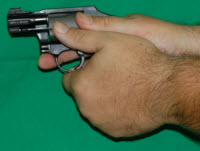


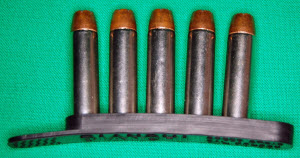
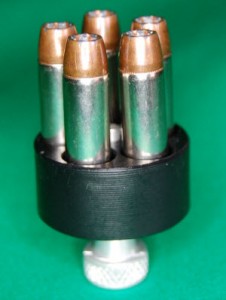
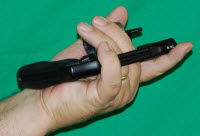
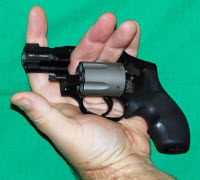
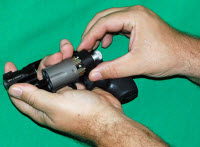
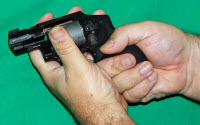
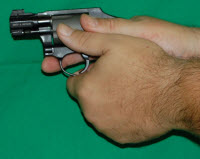
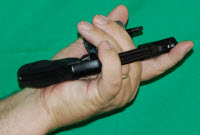
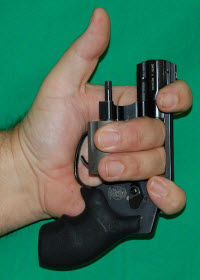
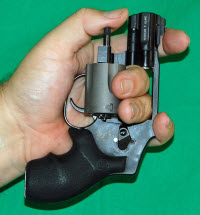
I carried a S&W model 19 when I first got in law enforcement and sometimes carry my 3" S&W 686...I still love a wheel gun!! We recently had to qualify with our duty guns and anything else we are going to carry on or off duty. I whipped out the wheel gun as one of my off duty carry guns. I can still shoot the revolver better than my semi-auto and reload faster than the guns on the range using a magazine. :) Speed loaders are the way to go for carrying extra ammo for sure, but if speed loaders are not in your arsenal here are a few ways to carry some extra revolver ammo. 1. Watch pocket: if you are wearing jeans most jeans still have watch pockets. I can put 6 extra rounds in the watch pocket. For right hand shooters it is in the right spot. 2. Speed strips: A totally enclosed cell phone case is a good choice for a couple speed strips. 3. Pocket: I have been know to carry a few loose rounds in my back pocket vs. my front pocket. For me my right back pocket is the best. We typically don't carry anything in our back pockets and the billfold can go on the opposite side.
Most all good comments and observations about how to use the round gun. My only concern is switching hands for reloading. I don't know why, but I've always kept it in my shooting (right) hand, and released the latch with right thumb. Then draw speedloader with left hand, tip arm up, push extractor rod with left hand, and tip arm down and reload with loader with left hand. Don't know if I'm wrong on this, but it seems that maintaining one's grip on the weapon is preferable to the method pictured?
thank you for a lodgical step by step opperation of reloading.
Very well explained and easy to understand .
I just joined PDN and this type of article is exactly what I was hoping for. Thanks, I feel I will learn a lot and really improve my home defense skills from visiting this site. Thanks PDN.